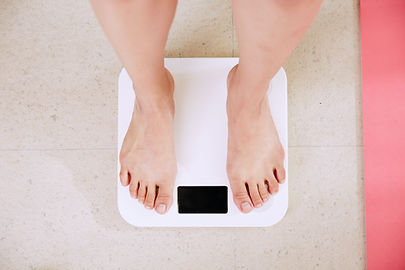
Diet and Weight Loss
Create a nutrition plan: The 5-step guide on how to develop your perfect weight loss nutrition plan
A diet plan for weight loss can be a really great help on the way to your desired weight.
Especially if you find intuitive eating difficult.
Such a plan tells you exactly how much you can eat and also guarantees an optimal distribution of nutrients. Properly implemented, it contributes significantly to your health and can also help you lose weight.
We will now show you how you can create a professional nutrition plan tailored to your needs.
At the end of the article, there is also a great surprise waiting for you 😉
Let's go!
Related Topics






We have collected the biggest advantages for you:
Healthy calorie deficit: Through an individual nutrition plan you can create a healthy calorie deficit and lose weight optimally and gently (more on this later).
Balanced nutrient supply: You achieve a perfect distribution between fats, proteins and carbohydrates.
Cooking time reduction: With the help of simple tricks you can reduce the time you spend in the kitchen by at least 50%.
Eat your fill of delicious dishes: Cook exactly the dishes you like and eat your fill.
Planning security: With a meal plan you can plan the whole week in advance. So you only have to think about cooking once.
Smart shopping: You can reduce the time you spend shopping many times over. One bulk purchase per week is theoretically enough
It all sounds too good to be true, doesn't it?
However, with a weight loss diet plan, you get to enjoy exactly these many benefits.
With such a plan, you'll significantly reduce the time spent planning your meals, shopping and cooking, and in return you'll get delicious, healthy and balanced meals that you'll enjoy and that will fill you up.
And on top of that, you'll lose weight because all the dishes are perfectly adapted to your energy needs!

It is not rocket science to create such a plan.
How exactly you have to proceed here, we tell you in this article step by step.
A note in advance: Of course, creating a nutrition plan takes time and can take a few hours. However, this effort is definitely worth it, because once you have a comprehensive plan, you can use it again and again.
And we won't leave you alone in this endeavor!
Now it's finally time for practice.
Let's create your weight loss meal plan together!
Pre-consideration: the most important features of your meal plan.
Before you start combining foods and creating dishes, you should do some preliminary thinking.
The more time you take for these considerations, the better the plan will suit you later on.
And that's really important.
A plan that is perfectly tailored to you should ensure that you actually lose weight.
In addition, practicality and your favorite foods are paramount: after all, you will only stick to the plan if you enjoy every dish and don't have to spend hours in the kitchen to do so.
The better the preparation, the greater the chance of achieving your desired weight.
It's that simple 😉
So be sure to pay attention to some important features when creating your diet plan to lose weight.
You can find out what these are in the following chapter.

1. customized and geared to your goals
Only a customized plan will help you lose weight.
A prefabricated "mass diet plan", on the other hand, definitely has no chance of success.
There is no "one size fits all" here.
By the way, this is also the reason why our nutrition plan works with a modular system and why you can adapt each day individually to your needs.
But why does the plan have to be individual?
Quite simply: every person has their own individual energy metabolism, their own culinary preferences and also individual illnesses or allergies.
Only if a nutrition plan addresses these issues and is adapted accordingly, then the plan can also accompany you in everyday life.
In addition, your nutrition plan must be perfectly matched to your goals.
Someone who wants to build muscle will use a completely different plan as a basis than a person whose goal is weight loss.
This automatically brings us to the next point.
2. suitable and convenient for everyday life
A diet plan MUST be suitable for everyday life and perfectly integrated into your daily routine.
Example...
It's no use to you as a professional if your plan consists of delicious and healthy dishes, but they require 2 to 3 hours of preparation time every day.
After a hard day's work, who wants to spend several hours in the kitchen in the evening cooking?
It's these little things that cause most plans to fail!
So as part of your preparation, work out exactly how much time you can and, above all, want to spend preparing food each day.
We have had the best experiences with nutrition plans that consist to a large extent of light and quickly prepared dishes.
For this reason, our plan also contains many dishes that can be prepared within a few minutes.

3. Healthy
Actually, it doesn't need to be emphasized that your diet plan should also be healthy!
After all, the ultimate goal is to lose weight and increase physical well-being.
Accordingly, you should make sure that the distribution of macronutrients is balanced (you'll learn how later) and that you rely on nutritious and vitamin-rich foods.
By the way, this will also help you avoid cravings.
And another thing that is often misunderstood: Eating healthy in no way means having to give up even delicious dishes that taste good.
Quite the opposite!
But more about that later.
4. flexible
You won't be able to stick exactly to your plan every day.
Sometimes a spontaneous dinner invitation will come up, other times you might not feel like eating the dish your plan actually calls for.
To make a long story short, it's important that your meal plan can withstand short-term changes and be flexible.
You could meet these requirements, for example, if you rely on a modular system and can easily use the foods you have already purchased the next day.
Practical guide: Create diet plan for weight loss
The first step in a nutrition plan should always be to look at your energy expenditure.
Before you can create dishes and fill your plan with life, you must first know the answer to the all-important question: How much can I eat?
You need to know what your daily energy needs are.
It's crucial that you don't rely on any rules of thumb here, but that you really calculate it as accurately as possible. This is difficult to do from home, because you can only get your exact basal metabolic rate if you have your individual metabolic rate determined by a doctor. However, our free calorie calculator offers a very good guide. It works with the most modern formulas to determine your energy needs as accurately as possible.
Create a meal plan to lose weight: You need to determine your individual energy expenditure before you can create a meal plan.
Our calculator will give you four very important results in no time:
Basal Metabolic Rate: amount of energy needed to maintain vital processes (organ function, cardiovascular system, etc.). It depends on age, sex, height, weight, muscle percentage.
Power metabolic rate: amount of energy depending on individual activity level of a person. It varies for each person
Total metabolic rate: sum of basal metabolic rate and power metabolic rate
Healthy calorie deficit: difference between total metabolic rate and actual calories consumed at a healthy and tolerable level.
All four values are equally important in order to create a diet plan that is perfectly suited to you.
And don't worry...
Even if the whole thing sounds relatively complex, it is much easier than you might think.
By the way: It is also important at this point that you calculate your total metabolic rate individually for each day.
Logical, isn't it?
While your basal metabolic rate will usually change little or not at all, your power metabolic rate can fluctuate considerably in a daily comparison. For example, if you cycle to work on one day and not on the other, then there is already a clear difference in the power metabolic rate, which you should also take into account in your diet.
Means: Calculate with our calculator really Monday to Sunday to get the most accurate values.
Step 2: Target definition and personal factors
What is the goal of your nutrition plan and what body is waiting at the end of your path?
This is the question we need to answer now.
In addition, we deal in this chapter with personal factors such as allergies or diseases.
1. define goals and calorie difference
You can have two different goals with your diet plan:
Lose weight: Here you need a calorie deficit.
Gain weight: Here you need a calorie surplus
The second option is mainly used if you want to build muscles. In these instructions, however, we are concerned with losing weight and therefore want to create a calorie deficit.
Now an important warning...
Please make sure that this calorie deficit is not too large!
A too large deficit may bring quick results, but on the other hand it will guarantee that you will stop losing weight after only a few days because you will feel hungry and tired. In this case, the yoyo effect is also pre-programmed.
In addition you endanger your health by a too large selected calorie deficit substantially.
We advise a deficit of about 20 percent. This will result in a deficit of between 250 - 400 calories per day for most people.
Please do not work with higher values.
You should definitely realize that losing weight is a long-term and steady process. With a slow and targeted weight loss, you not only increase the chance of reaching your desired weight, but also of maintaining it permanently.
And also with a healthy calorie deficit you will reach your goal faster than you might think.

2. personal factors
Also a very important issue when creating a diet plan are personal factors such as diseases and allergies.
If you suffer from either of these, please do not create a plan on your own. Even our free downloadable nutrition plan is not suitable in this case!
Please consult a doctor in any case. Discuss with him how an individual nutrition plan could look like for you.
The same applies to you if you are pregnant or if you have recently given birth or are breastfeeding: Please be sure to talk to your gynecologist first!
Step 3: Macronutrient distribution
Now that you know your daily energy needs and have determined the amount of calories you need to lose weight, the next step is to create the skeleton of your meals: the macronutrient distribution.
Here you define how much fat, how much protein and how much carbohydrates a dish should consist of.
In order to end up with a balanced and healthy diet plan, you should not mix ingredients on the off chance, but always make sure to have a sufficient amount of each macronutrient in the dish.
Of course, you could focus solely on calories - that would work and you would definitely lose weight if you stick to that deficit.
However, we strongly recommend that you also pay attention to a healthy composition.
So what is the optimal macronutrient distribution?
Difficult question!
A unified opinion cannot be found even among experts. True to the motto "Ask 10 experts and you'll get 10 opinions", there is no right or wrong here.

Step 4: Food selection
Now you can finally start creating your diet plan and filling each day with delicious dishes.
Although your plan should really be very individualized to your taste preferences, we still recommend that you keep in mind some important basics.
Not every food is suitable for weight loss.
You will now learn what is important here.
Protein

Protein
Protein is the building material of the body and an elementary component of muscles.
It is therefore advisable to build on a high protein content, especially in the evening or with snacks.
However, you should not overdo it, because too much protein in the diet is not healthy. Numerous studies have shown that too much protein significantly increases the risk of cancer.
You should also make sure to get protein from plant-based foods as much as possible.
These are good sources of protein:
Red lentils
Kidney beans
Peas
Dairy products
Beef
Turkey
Chicken
Tofu
Fish
Carbohydrates

At the latest since the advance of low carb, carbohydrates are probably the most hated macronutrient.
A reputation, however, that is not entirely fair.
Carbohydrates are energy suppliers, similar to fats. However, carbohydrate stores in the body are not really large and quickly filled completely. Excess carbohydrates are therefore converted into fat, which is mainly responsible for the bad reputation of this macronutrient.
However, to do completely without carbohydrates would be wrong.
At this point, it is crucial to focus on the right carbohydrates. Namely, those that consist of long-chain molecules. These types of carbohydrates have a long cleavage time and therefore provide your body with energy for a long time.
These are good carbohydrates:
Whole grains
Oatmeal
Sweet potatoes
Rice
Fruit
Vegetables
Hands off, on the other hand, applies to sugar!
Fat

Fats (unfortunately) also enjoy a very bad reputation.
However, it is also similar here as already with carbohydrates: There are good fats and bad fats.
Good fats are an important part of a healthy and balanced diet. They fulfill numerous important tasks in your body.
Fats are divided into two types:
Saturated fats: found in sausage and convenience foods. The really nasty trans fats (e.g. in sweets, potato chips, fast food) also belong to this group. Hands off!
Unsaturated fatty acids: Should be an integral part of your diet. For example, they ensure vitamin absorption
These are good sources of fat:
Fish
Nuts
Olive oil
Chia seeds
Avocado
Important: Energy density/calorie density
Now that you have an overview of the three macronutrients, we need to move on to calorie density, which is also extremely important in this context.
It indicates how many total calories are contained in a food.
Simple rule: You can eat significantly more of a food with a low calorie density and fill your stomach. This creates a much longer lasting feeling of fullness without compromising your calorie deficit.
The calorie density is calculated in a relatively simple way: The calories of a food per 100 grams are divided by the number 100. For example, a cucumber has a caloric density of 0.1 (10 kcal/100g : 100).
Fill your diet with delicious ingredients that have a low energy density.


